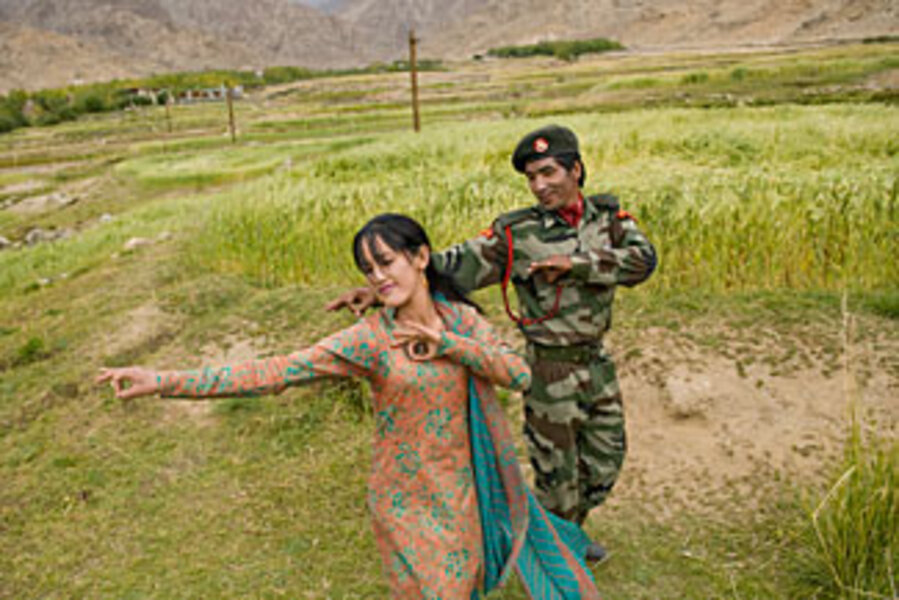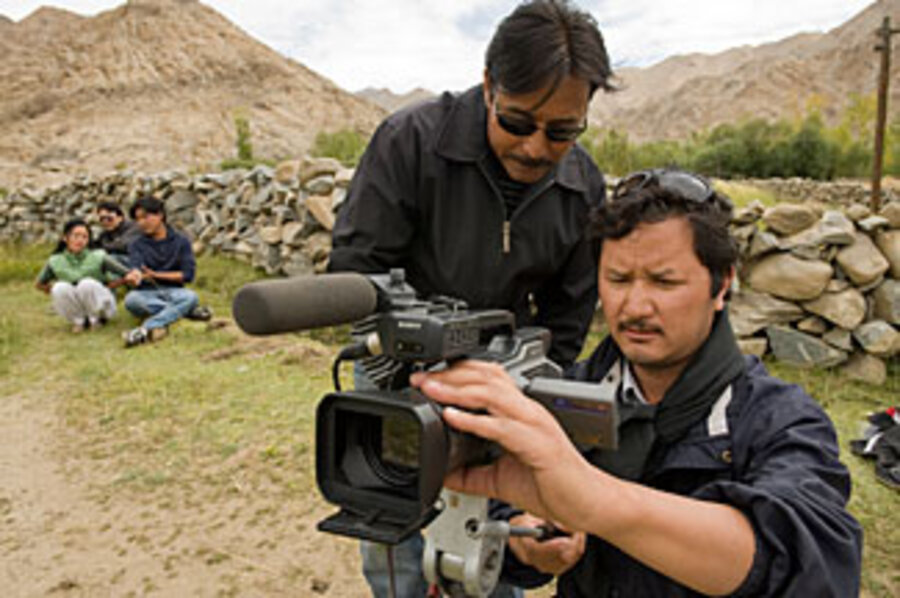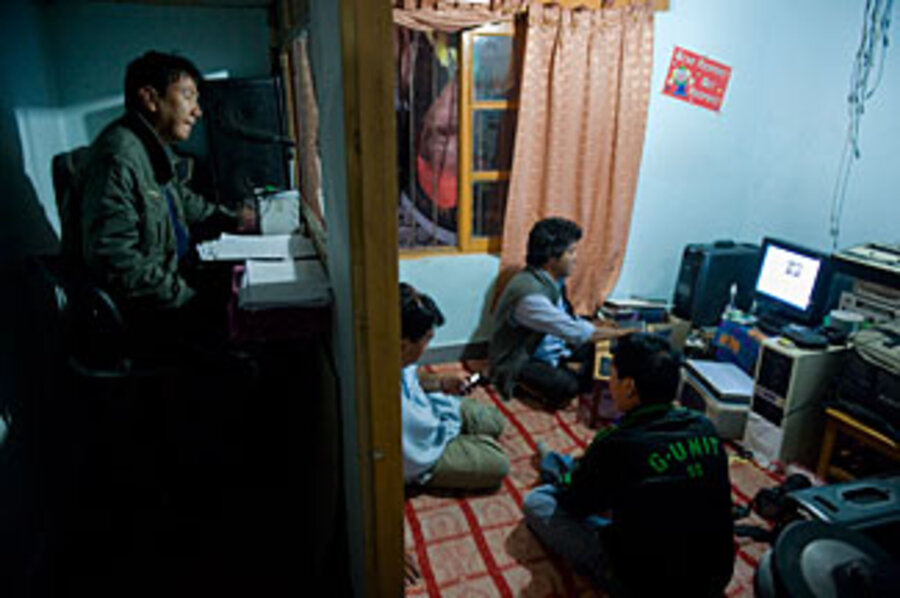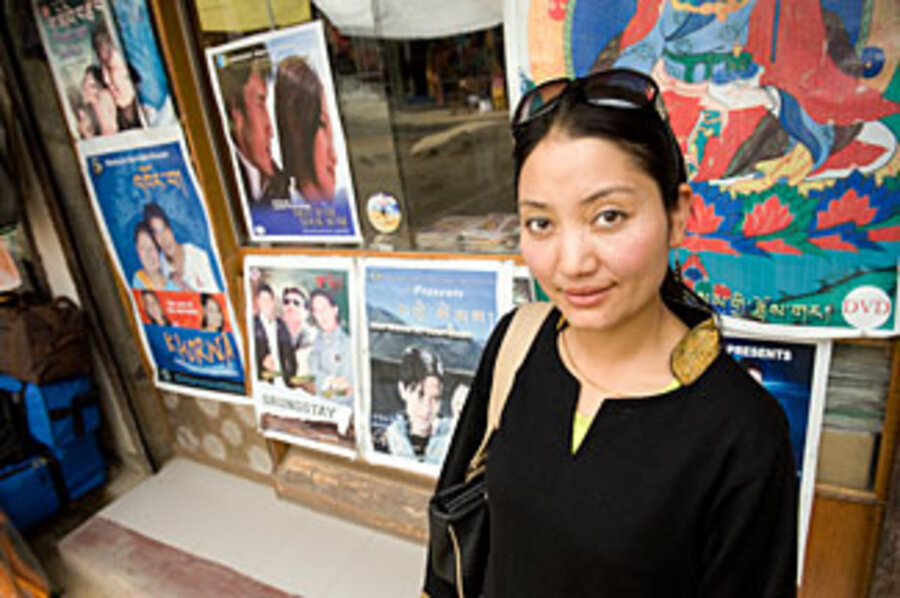Local Ladakhi films trump India's Bollywood in Himalayas
Loading...
| Ladakh District, India
Around every corner in this distant Himalayan district of India, someone is in the movies. Bureaucrats and Buddhist monks write screenplays, taxi drivers and cops play villains and heroines, and the superstar actress gets paid $1,000 a movie.
Ladakhi films première to packed crowds in the capital, Leh, in an auditorium just off the polo field. Then they head to the villages, shown with LCD projectors and portable speakers. In this northern nook of India bordering China and Pakistan, Bollywood no longer holds sway.
The film industry here emerged right about the time, early in this decade, that cellphone towers and tourists saturated this once-isolated community. Ladakhis quickly put 21st-century social media toward preserving a traditional culture they felt was under siege.
"The young generation nowadays are influenced by the Western people – what they eat, how they dress," says Dorjay Khanang, a former soldier and one of the founders of Ladakh Vision Group, the region's original film studio. "Through these films, we are saying we have our own culture and tradition from ancient times in Ladakh."
Their brand of traditional movies turned out to be wildly popular.
"Traditional," explains Mr. Khanang, means using Ladakhi language and clothes. Modern roads and vehicles are nowhere to be seen. But portraying a Shangri-la that was can be a challenge.
"There are only a few places we can shoot," says Tashi Dawa, a local filmmaker, "because everywhere there are electric wires, cell towers, and greenhouses."
For a recent "blockbuster," titled "Las-Del" ("Karmic Connection"), Mr. Dawa explains how an electricity pole got in the way of a bucolic scene. Their solution? Cover it in Buddhist prayer flags.
There's a tinge of irony in the backlash against modern technology, since ultramodern digital video and movie-editing software made this regional film industry possible. Outside filmmakers say some of the Ladakhi films are starting to show high production values.
Last year, for example, the Ladakh Vision Group bought a 30-foot film crane. It enabled them to stage a scene in "Las-Del" in which a boy, girl, and horse topple off a cliff.
"People in the theater got up and shouted; some people didn't want to look. They hadn't experienced such a [realistic] scene in Ladakhi film," says Dawa. "After seeing the movie, many people said to me: 'This time you did a very difficult job – you climbed on trees.' I said, 'No we used a crane.' And they said, 'What's a crane?' "
Change is rippling through the thin air of Leh town, which is 12,000 feet above sea level. The number of tourists has more than quadrupled since the turn of the century, to 74,000 last year.
Only 115,000 people actually live in the district of Ladakh, mostly in villages nourished by glacial runoff and watched over by medieval monasteries. Cellphone towers are no more than five years old; satellite TV is another newcomer.
But after an initial invasion of English and Hindi songs, films, and pop culture, it's once again Ladakhi songs that are played in the taxis and the hotels.
"There is this massive insecurity that Ladakh culture is disappearing," says Shabani Hassanwalia, codirector of a new documentary, "Out of Thin Air," about the Ladakhi film industry. "They basically feel everything opened up too quickly to foreigners and foreign ideas."
The violence of Hollywood does not resonate with the pacifist Buddhist traditions here. Indian cinema, meanwhile, barely reflects this corner of India – rarely casting mountain peoples whose looks place them more in harmony with Tibet than with Delhi.
"Our eyes are smaller and noses smaller – our features are different. Maybe Bollywood people wouldn't like to take us," says Stanzin Namdol, the leading Ladakhi actress who was paid a record $1,000 for her role in "Las-Del." Shy little girls now come up to her and ask for autographs, quickly hiding behind someone else after handing up the pen and paper.
Ladakhis naturally want to see people like themselves on the silver screen, says Ms. Hassanwalia. They also want to see their Ladakhi values on display.
"In Ladakh, the family structure is very strong, and everybody celebrates together," says Hassanwalia. "So movie-watching is a family experience, and they believe that Bollywood is becoming racier and racier, and so you can't watch it as a family any more."
Ladakh cinema actually marks a return to Bollywood's roots.
For their rupees, audiences expect to shed some tears over lovers thwarted by parents because of caste, class, or ethnic divides. Stunning mountain scenes form the backdrop for song-and-dance interludes.
Even the rare comedy reflects innocence. A former Buddhist monk, Thinlay Norbu, wrote a comedy script in the wee hours before 3:30 a.m. prayers. The funniest scene, he explains, is when two thieves try to escape on a donkey and fall down.
Six months ago, Mr. Norbu says, monastery politics grew unbearable for him, and he cast off the crimson robes in favor of sunglasses, jeans, and a Dockers denim shirt.
"Before, I was a monk, so I couldn't write love-story scripts," says Norbu. Now he's met a girl named Tajin. "I am already in love, and through this experience, I find it easy to express myself and to write the script."
At a local film shoot two lovers, running hand in hand through a barley field, find a spot they think will be safe for smooching. But no sooner do they sit down than a farmer pops up from a hole in the ground. The lovers feign surprise.
"Tikh hai! Good!" shouts director Tundup Dorjay, pleased that on this second take, actress Sonam Spaldon followed his advice about how to act frightened.
He takes out an old Philips tape deck and presses "play," replacing the pastoral sounds of yak bells with sugary Indian singsong. Ms. Spaldon launches into her dance routine – but Mr. Dorjay soon steps in to demonstrate, swaying his hips while bending his knees like a downhill skier.
Like most actors in Ladakhi films, Spaldon has no experience.
"She's got a pretty face, and she's interested in acting, and if someone is interested in something, we have to get them involved," says Dorjay.
The plot of this yet-untitled film involves an orphan girl who has inherited both a lot of property and a scheming aunt as her guardian. The aunt tries to marry off the girl to a bad man in order to steal her property, but the girl instead breaks taboos by falling for a poor Tibetan boy instead.
"This kind of story is happening in many places," says Rigzin Dhondup, the actor who plays opposite Spaldon. "Some of the parents watching the film – maybe they will change their mind and be better toward their children."
Such romantic taboos are receding somewhat from Bollywood scripts about India's dizzying urban liberalization and its quest for riches. But such themes remain central in rural Indian life.
"Bollywood now is increasingly about urban India," says Hassanwalia, the documentary filmmaker. "In fact, it is almost entirely about urban India because we have multiplexes and that's where the paying audience is."
But there's some money in the makeshift theaters here to support an indigenous industry. Tickets run about a dollar, depending on the venue. Popular movies might run for a month in the 250-seat capacity Leh theater, then continue in the countryside. Then there are CD and DVD sales in the local markets several years after the film's release.
Out of the roughly 28 films made since the industry began in 2003, about six or seven made money, figures Dawa.
It cost Ladakh Vision Group $30,000 to produce "Las-Del." It will make a "good profit," the group says, thanks to its being dubbed into Tibetan – that will broaden its audience. But any profits will be plowed back into equipment upgrades and charity, they say.
"We cannot make a big-budget film here. If we make a really good film, it is likely to go over budget," says Tsering Angdus, a cofounder of Ladakh Vision Group whose day job is public relations for the government. "If we have a good budget and new equipment, we could go for a film of international standards."
The perception of big profits is making it harder to stay under budget.
Dawa recounts a recent run-in with a farmer midway through a shoot in the farmer's field. He demanded $20 for the time the crew spent on his land – then insisted they finish shooting and pay him another $20. And while the actors at Dorjay's shoot all worked free of charge, some actors now ask for thousands of dollars – despite having zero experience.
The creeping commercialization does provide new jobs for local youths – and encouragement to aspiring filmmakers worldwide.
Hassanwalia says that it was at once exciting and humbling to have just graduated from film school, only to see a group of untrained amateurs making technically advanced films with an old PC and some manuals downloaded from the Internet.
"We were very inspired by them," says Hassanwalia. "And now people who watch [our] film say, 'If they can do it, we can do it.' "








